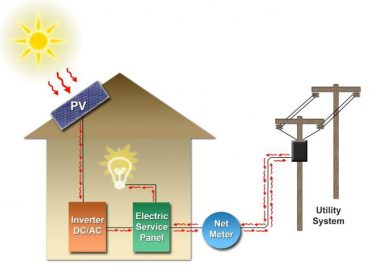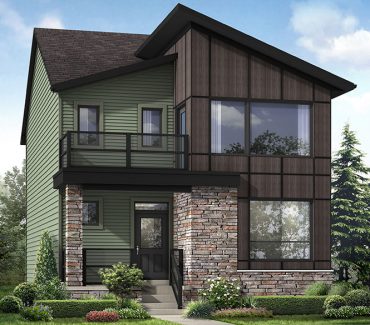
John Bleasby
Net Zero Energy homes for everyone by 2030?
Canadian ContractorIf the Trudeau government has its way, all new homes must be NZE in 15 years. Wow.
Everyone knows that Ottawa has ambitious goals for the reduction of greenhouse gasses (GHG) produced in Canada. What has not been so well publicized is that the Liberals have a dream that, by 2030, all new homes in Canada will be built to Net Zero Energy (NZE) standards.
Is our industry that important to the fight against global warming? Environment Canada thinks so. It says that 11 per cent of Canada’s greenhouse gasses are emitted from buildings (and even more if gasses resulting from the required power generation for lighting and cooling are included). So, yes, our industry is going to be impacted by stringent greenhouse gas regulations. And NZE is a term we are going to hear a lot.

What looks like a simple matter of adding PV’s to the roof is actually just part of an an expensive NZE upgrade process.
What is Net Zero Energy?
Zero Net Energy (NZE) is a house that produces energy equal to what it consumes overall, usually achieved through very high levels of insulation, heat pumps, and an array of PV’s (photovoltaics) on the roof. That’s a tall order, and something that has only been deliverable in a selection of government/corporate sponsored pilot projects across the country.
Even so, some of those pilot homes are in fact only Zero Net Energy Ready (ZNEr), a labelling that means the house has superior insulation for example, but lacks the power generation components required to balance energy consumption with energy production.
CHBA: NZE-for-all must pass through an established building code process
How these potential changes will play out is a concern for the Canadian Home Builders Association (CHBA) based In Ottawa. Canadian Contractor spoke with their director of communications, David Foster, who told us that the association categorizes the government’s NZE musings as “policy guidance” that will be taken ultimately to the Canadian Commission on Building and Fire Codes, an independent organization that develops the national building code in consultation with the provinces, territories and industry.
Like the code changes from the 1980’s that led to the R2000 standards, ZNE/ZNRr codes would have a significant impact on the industry. “When R2000 came out in the ‘80’s, it was a pretty radical notion,” recalls Foster. “It took a number of years for the industry to figure out how to do it in a practical, affordable and durable way.”

Mattamy’s NZEr homes look like any other. However, the total additional turnkey cost for true NZE is about 15% – 20%
Many issues need to be addressed
That’s the challenge again today and over the next several years, according to Foster. “It’s nice to say, ‘Wouldn’t it be great if all homes were NZE, say 15 years from now.’ But as Mattamy and Minto have suggested as a result of their pilot projects, the primary concern is always going to be affordability. [NZE turnkey homes cost between 15% – 20% more than an identical current code-built home.] We’re building NZE and NZEr today, but only on a very limited basis. When you scale something up industry-wide, there are a whole host of issues: replicability, scalability, for example. Access to sunlight is important for active or passive solar. How do we layout of sub-divisions? How do you build an urban NZE house in the shadow of an apartment tower? What changes would be needed in order to put in homes that would perform?”
Nevertheless, Foster says the CHBA is not in a panic. “While we don’t buy into a deadline concept, when we hear dates like 2030, it’s not imminent and there should be enough time to determine whether it’s a practical thing or not,” he says. “If we determine that there are certain aspects that make it impractical at a certain point, we assume they will be adjusted accordingly.”
The residential construction industry must make its voice heard
Like the CHBA, all home builders need to be thinking ahead about what code changes would make sense in the pursuit of the government’s overall GHG objectives, and expressing them to their local building associations and to the CHBA. “Until the Minister formally lays out the plan, we can’t respond with any precision,” says Foster. “However, one thing we’re making clear is; if this is the policy direction, we expect that once that goal is enunciated that there would be a parallel commitment to work with our industry to continue to develop this technology, to address affordability, and all the other issues that can’t be overlooked.”
follow John on Twitter @john_bleasby
Advertisement
Print this page

While this might mean that our own company will see our competitive edge eroded over time (we presently succeed in part by being among the few builders and renovators who automatically seek to bring their projects to or near NZ or Passive House std), I am happy to see this.
Housings costs grew by a proportionately larger percentage over the last few decades due to increase in footprint and further, in normalizing what once were upgrade items (remember when granite was considered a high-end countertop?); said differently, ego has been a bigger driver of costs than will be the price of more efficent homes. And the latter, done carefully, can approach cashflow neutral to the owner – that is the extra outlay is paid for out of reductions in ordinary utility bills – so is it really more expensive? Higher price – yes; higher cost – not as much.
From my way of thinking – and that of our clients – we can do the planet & the next generation some good, reduce our own dependence on/cost of utilities, AND still have our granite.
And by the way, while we are debating when we get to this standard, the EU long ago beat us to it…with fewer than 15 yrs in the making, (I believe) they last year moved to having all new residential construction reach Passive House level. So it will be cheaper and easier for us to integrate because the technologies & strategies already exist…of course because we were laggards it means that we haven’t nurtured a domestic industry in creating these next generation products but that is another discussion for different publication. 😉
Thanks for your post, Ben. For those who don’t know Ben personally (he’s been a contributor to our magazine since our inception), he is one of the most authoritative working contractors on eco-building technniques in North America, and we certainly take his encouraging words very much to heart.
Ben, you’re absolutely right, we all need to push in this direction, for us and the generations to come. This standard should be more expansive? I don’t think so, perhaps the investment will be lager on the beginning, but then in the long run it will be less expansive since the building materials will also be on another level, more durable and (in many cases) more environmentally friendly to have a comfortable living which means no petroleum products to design a permeably system.
The “standard building technique” might worked out 15 years ago when a mortgage term was 15 years, then when it was paid of the shell (roof shingles, window, doors etc.) required already some major renovations.
Now it has changed quite a bit, the mortgage terms are in most cases stretched to 30 years, but the “regular” building materials have not been improved, so for me it is senseless to build “cheap” and pay mortgage on material on the dump for another 15 years….who can afford that??
Also in regards to the EU standard, yes, in many countries is the standard on the passive since a while, and by the time we reach here zero their goal is plus-energy.
So not only Barak Obama can say “Yes we can”, we can it too:-)
Except BC’s new Step Code scheduled for 2018 fast-tracks Passive and Net Zero homes adding significant costs to construction depending on your municipality. Visit http://www2.gov.bc.ca/gov/content/industry/construction-industry/building-codes-standards/energy-efficiency/energy-step-code
Here is our view http://www.vrba.ca/step-code-step-public/
Also covered by Les Leyne in the Times Colonist http://www.timescolonist.com/opinion/columnists/les-leyne-province-taken-to-task-for-housing-costs-1.2363932
Thanks, Casey. Great info to know.
Hi, and thanks for the info. I have do have a question I’d love to hear you’re insight on. I’ve been doing some research recently on all of this, and it seems to me in all of these efforts (as you’ve pointed out regarding the issues using solar, the cost of building these homes, etc), one major contributor to far more energy-efficient homes that does not cost any more, and that is NOT being talked about, is the use of Structural Insulated Panels. In all of these talks about building green homes, everything seems to be focused on expensive new tech like solar, better HVAC systems, etc etc. While all that stuff is good, you’re right, it’s expensive. But why is one method that is very efficient, and not expensive to use, not being talked about anywhere? From my research, it seems like half the battle can be won (plenty of studies showing a minimum of 50% improvement compared to traditional framing methods) starting with this one approach alone. Would love to hear what you think about this. Thanks!
Hi Rob:
We have reported on both SIPs and ICFs over time… more on ICFs this year, for sure. Thanks for the reminder on SIPS. We should revisit them. Are you using then? I’ve sent you a private email.
Thanks for reading us.